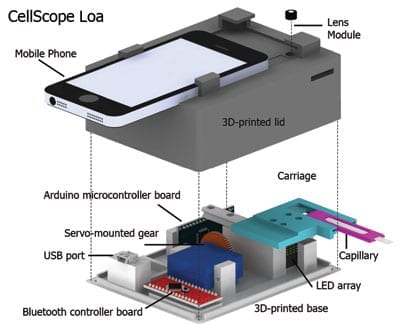
Lens Could Give Schools, Clinics Low-Cost Alternative to Conventional Equipment
Researchers at the University of Houston have created an optical lens that can be placed on an inexpensive smartphone to amplify images by a magnitude of 120, all for just 3 cents a lens.
Wei-Chuan Shih, assistant professor of electrical and computer engineering at UH, said the lens can work as a microscope, and the cost and ease of using it – it attaches directly to a smartphone camera lens, without the use of any additional device – make it ideal for use with younger students in the classroom.
It also could have clinical applications, allowing small or isolated clinics to share images with specialists located elsewhere, he said.
In a paper published in the Journal of Biomedical Optics, Shih and three graduate students describe how they produced the lenses and examine the image quality. Yu-Lung Sung, a doctoral candidate, served as first author; others involved in the study include Jenn Jeang, who will start graduate school at Liberty University in Virginia this fall, and Chia-Hsiung Lee, a former graduate student at UH now working in the technology industry in Taiwan.
The lens is made of polydimethylsiloxane (PDMS), a polymer with the consistency of honey, dropped precisely on a preheated surface to cure. Lens curvature – and therefore, magnification – depends on how long and at what temperature the PDMS is heated, Sung said.
The resulting lenses are flexible, similar to a soft contact lens, although they are thicker and slightly smaller.
“Our lens can transform a smartphone camera into a microscope by simply attaching the lens without any supporting attachments or mechanism,” the researchers wrote. “The strong, yet non-permanent adhesion between PDMS and glass allows the lens to be easily detached after use. An imaging resolution of 1 (micrometer) with an optical magnification of 120X has been achieved.”
Conventional lenses are produced by mechanical polishing or injection molding of materials such as glass or plastics. Liquid lenses are available, too, but those that aren’t cured require special housing to remain stable. Other types of liquid lenses require an additional device to adhere to the smartphone.
This lens attaches directly to the phone’s camera lens and remains attached, Sung said; it is reusable.
Read more: UH Researchers Create Lens to Turn Smartphone into Microscope
The Latest on: Smartphone microscope
[google_news title=”” keyword=”Smartphone microscope” num_posts=”10″ blurb_length=”0″ show_thumb=”left”]
via Google News
The Latest on: Smartphone microscope
- Sigma Field Emission Scanning Electron Microscopes from Carl Zeisson April 29, 2024 at 5:00 pm
Atlas 5 is the powerful yet intuitive hardware and software package that extends the capacity of your scanning electron microscope. An advanced analysis and visualization software solution for ...
- Oklahoma airport under TSA microscope after Turks and Caicos jails dad found with ammoon April 25, 2024 at 12:31 pm
TSA is investigating an Oklahoma airport after security apparently failed to notice ammunition in a traveler's backpack that led him to be arrested in Turks and Ciacos. Ryan and Valerie Watson ...
- I ditched my smartphone for a year and a half: 'I felt much more in the flow and had more mental energy'on April 24, 2024 at 12:20 pm
Anastasia Dedyukhina spent a lot of time on her smartphone when she worked in digital marketing; so much so that she wasn't sure if she was selling a product or if she was one. Dedyukhina's next ...
- I ditched my smartphone for a year and a half: ‘I felt much more in the flow and had more mental energy'on April 23, 2024 at 5:00 pm
Anastasia Dedyukhina spent a lot of time on her smartphone when she worked in digital marketing; so much so that she wasn't sure if she was selling a product or if she was one. Dedyukhina's next ...
- Best Gifts for Kids of 2024on April 23, 2024 at 1:36 pm
The best gifts for kids provide the perfect balance of play and education. We spoke with experts and vetted the best gifts to make the whole family happy.
- Hybrid camera system gives your smartphone "super-telephoto" zoomon April 18, 2024 at 5:43 am
Tech company Beaverlab has launched a Kickstarter to raise funds for a smart super-telephoto camera called the Excope DT1 that can be had with a 400-mm zoom lens, and works with a smartphone to ...
- The Fascinating Way to Measure Glucose With a Phone's Compasson April 17, 2024 at 5:52 am
The compass inside smartphones is a magnetometer — it measures magnetic fields. Normally it detects the earth's magnetic fields, but it can also detect small, nearby magnets and changes in those ...
- Social psychologist urges parents to keep smartphones away from kids to 'protect' their mental healthon April 11, 2024 at 1:00 pm
Smartphones are creating an anxiety and depression-riddled generation of teens, according to social psychologist and New York University professor Jonathan Haidt, but there are steps parents can ...
- The best microscopes for students in 2024on April 10, 2024 at 1:00 pm
Here are the microscopes to help them get started. This classic microscope is made with students’ needs in mind. It can connect to a laptop or other screen for group viewing, helping large ...
- Doctor reveals what a ‘slice of penis’ looks like under a microscope — viewers are ‘riveted’on April 4, 2024 at 5:41 pm
A British doctor has shocked by showing TikTok users what a "thin salami slice" of penis looks like beneath a microscope. AzmanJaka You might not be ready for this close-up. A British doctor has ...
via Bing News










